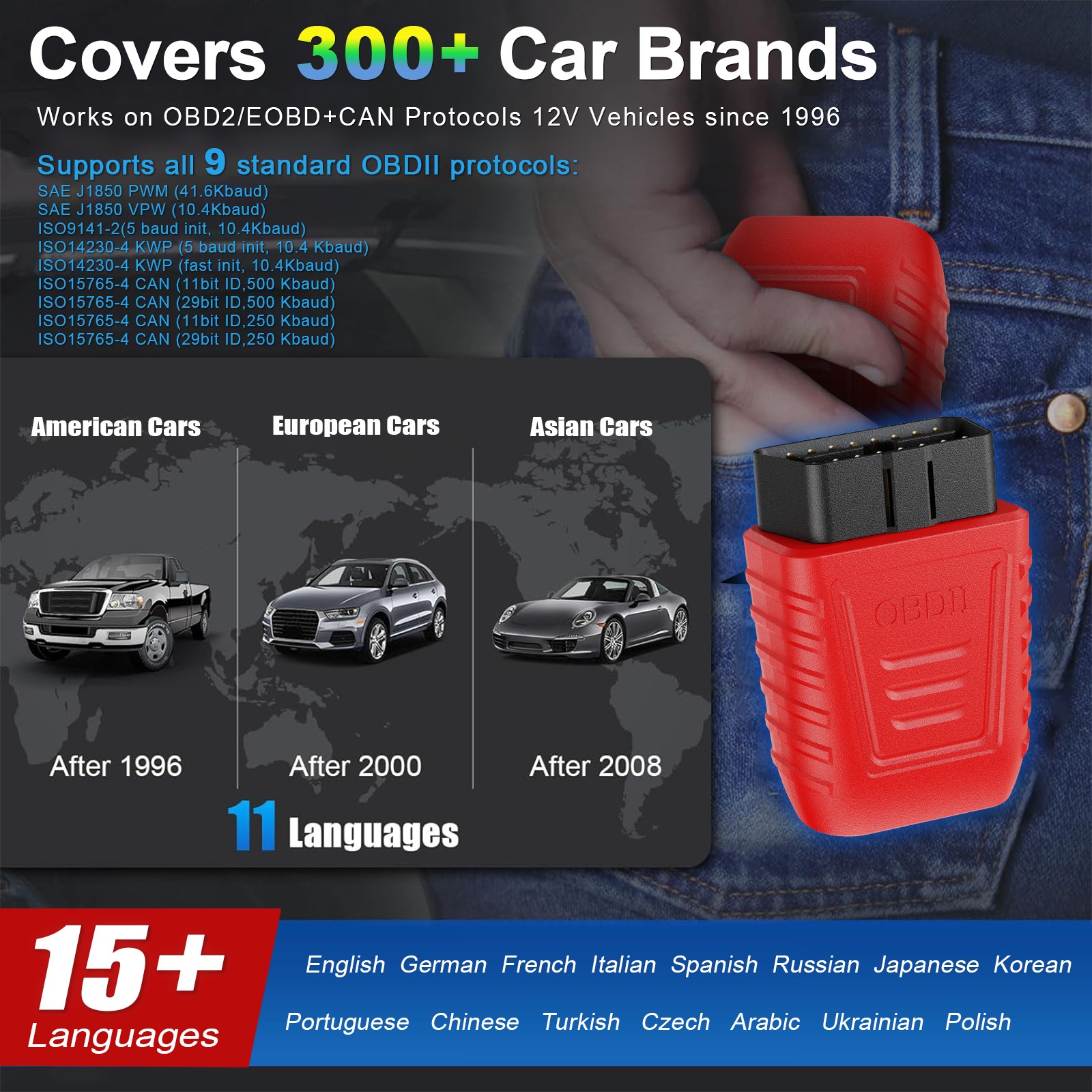Now lots of OBD2 scanner tool supported 9 Kinds of protocols, here are the details analysis of it all:
1. SAE J1850 Pulse Width Modulation (41.6Kbaud)
- Technical Overview: A legacy protocol using a two-wire differential signal (PWM) for communication. It operates at 41.6Kbaud with dominant/recessive bit arbitration and supports Ford vehicles manufactured before the mid-2000s.
- Market Relevance: Rarely used in modern vehicles but still supported by advanced diagnostic tools (e.g., Autel MaxiSys) for compatibility with older Ford models.
- Challenges: Limited data bandwidth and susceptibility to noise compared to CAN-based protocols.
2. SAE J1850 VPW (10.4Kbaud)
- Technical Overview: A single-wire protocol (Variable Pulse Width) with 10.4Kbaud speed, primarily used in GM vehicles. Bits are encoded via pulse-width variations (34–163μs).
- Market Relevance: Found in pre-2008 GM and Chrysler vehicles. Tools like Snap-on Verus Pro include VPW support for fault code retrieval and emissions testing.
- Key Features: Simplified wiring but lower data throughput compared to PWM.
3. ISO 9141-2 (5-baud initialization, 10.4Kbaud)
- Technical Overview: A K-line-based protocol requiring a 5-baud initialization handshake. Used in European and Asian vehicles (e.g., Toyota, BMW) for basic diagnostics.
- Market Relevance: Largely phased out post-2008 but still critical for older models. Tools like Launch X431 support ISO 9141-2 for reading emissions-related DTCs.
- Limitations: Slow initialization and lack of support for advanced diagnostics.
4. ISO 14230-4 KWP (5-baud initialization, 10.4Kbaud)
- Technical Overview: An enhanced version of ISO 9141-2, also known as Keyword Protocol 2000 (KWP2000). It uses a 5-baud wake-up sequence and supports bidirectional communication for deeper ECU access.
- Market Relevance: Common in early 2000s European vehicles (e.g., Volkswagen, Audi). Tools like Bosch ESI[tronic] leverage KWP for ECU coding and parameterization.
- Advantages: Improved error handling over ISO 9141 but slower than CAN.
5. ISO 14230-4 KWP (Fast initialization, 10.4Kbaud)
- Technical Overview: Similar to KWP2000 but skips the 5-baud handshake for faster communication. Ideal for ECUs requiring rapid diagnostics.
- Market Relevance: Used in select Japanese and European models (e.g., Mazda, Volvo). Supported by advanced scanners like the ThinkDiag for real-time data streaming.
6. ISO 15765-4 CAN (11-bit ID, 500Kbaud)
- Technical Overview: The dominant protocol in modern vehicles, adhering to CAN 2.0A (11-bit identifiers). Operates at 500Kbaud for high-speed communication, critical for engine control and safety systems.
- Market Relevance: Mandatory for post-2008 vehicles in the U.S. and EU. Tools like Autel IM608 and OE-grade devices (e.g., ODIS) rely on this protocol for UDS (Unified Diagnostic Services).
- Benefits: High reliability, error-checking via CRC, and support for multi-ECU networks.
7. ISO 15765-4 CAN (29-bit ID, 500Kbaud)
- Technical Overview: Extended CAN (2.0B) with 29-bit identifiers, allowing more nodes and proprietary manufacturer-specific messaging. Used in heavy-duty vehicles and luxury brands (e.g., Mercedes).
- Market Relevance: Limited to niche applications but critical for commercial fleet diagnostics. Tools like Jaltest Trucks include 29-bit CAN support.
8. ISO 15765-4 CAN (11-bit ID, 250Kbaud)
- Technical Overview: A lower-speed variant (250Kbaud) for non-critical systems like body control modules or infotainment. Uses 11-bit IDs for simpler networks.
- Market Relevance: Found in economy vehicles and hybrid/electric cars (e.g., Toyota Prius). Tools like Carly Universal Adapter use this for battery monitoring.
9. ISO 15765-4 CAN (29-bit ID, 250Kbaud)
- Technical Overview: Combines 29-bit IDs with 250Kbaud speed for specialized applications, such as agricultural or industrial vehicles.
- Market Relevance: Rare in passenger cars but supported by industrial-grade tools (e.g., Texa IDC5).
Current Trends in Diagnostic Tools
- Multi-Protocol Support: High-end tools (e.g., iKiKin OBD2 Scanner ) integrate all nine protocols to ensure compatibility across legacy and modern vehicles.
- Wireless Connectivity: Bluetooth/Wi-Fi-enabled adapters (e.g., iKiKin V011 DA100 ) prioritize CAN and KWP protocols for real-time telematics.
- UDS Dominance: ISO 15765-4 (CAN) and ISO 14229-1 (UDS) are now standard for advanced diagnostics, including ECU programming and cybersecurity.
- Legacy Phase-Out: SAE J1850 and ISO 9141 are gradually being deprecated, with CAN accounting for >90% of post-2010 vehicles.
Post time: May-28-2025











